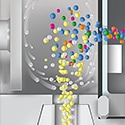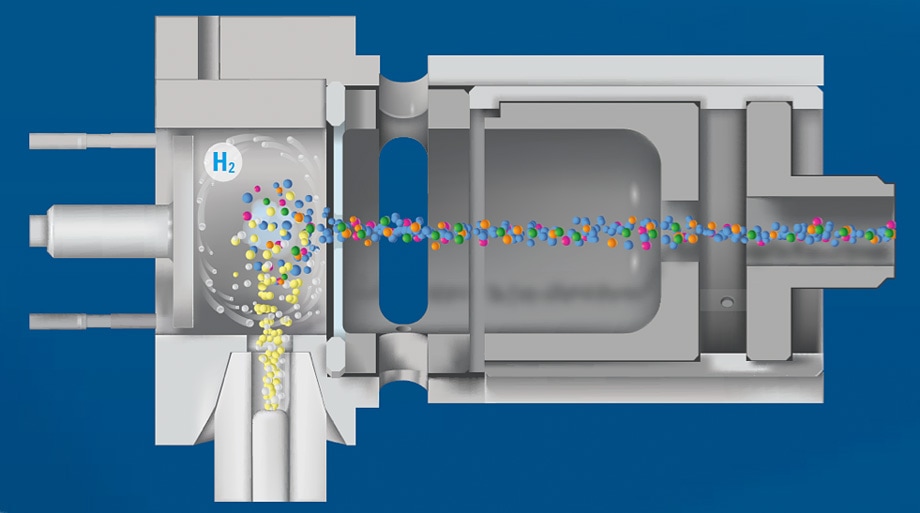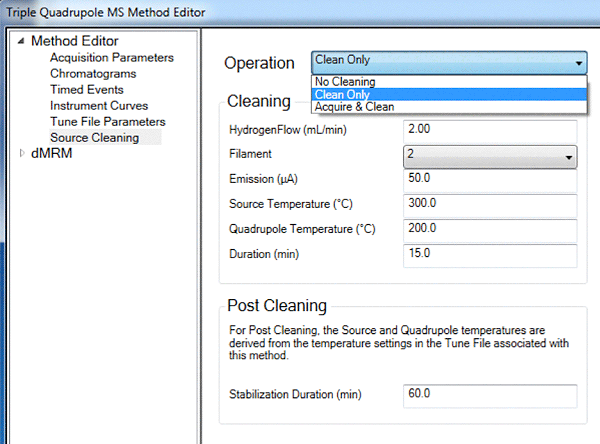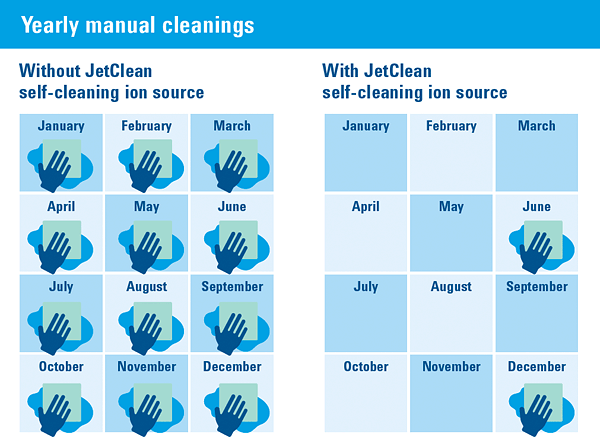Access Agilent eNewsletter November 2016

Agilent JetClean self-cleaning ion source means you clean less, analyze more
Elizabeth Almasi, Agilent Application Manager, Mass Spectrometry Division
During routine GC/MS analysis, matrix deposits inevitably build up in the MS ion source. As a result, an operator must be present to routinely remove the ion source, clean the lenses and other source components, then put it all back together and pump down and recalibrate the instrument. Now the patented Agilent JetClean self-cleaning ion source greatly reduces or even eliminates the need for manual source cleaning for Agilent single and triple quadrupole GC/MS systems.

Figure 1. Cross-section of the Agilent JetClean self-cleaning ion source, which uses precisely controlled hydrogen flow to keep the ion source clean from contamination.

Figure 2. The straightforward Agilent MassHunter software user interface gives you the power to customize settings for automated MS ion source cleaning.
Agilent JetClean (Figure 1) uses a unique mixture of helium and hydrogen to clean the ion source. JetClean allows labs to maintain response for months, or even years, so they can avoid tedious and frequent manual source cleaning. As a result, they can increase productivity and profitability. JetClean is available as an option on new or as an upgrade on existing Agilent single quadrupole and triple quadrupole GC/MS systems.
JetClean control is fully integrated in the Agilent MassHunter Workstation software, allowing easy, simple setup and operation. Parameters are saved in the method (Figure 2) and in the instrument log file, and are readily portable.
Flexible cleaning modes put you in control
Agilent JetClean has two operational modes. In the “clean only” mode, analysis takes place in an inert helium-only environment. If the measured analytes interact with hydrogen or if you use chemical ionization (CI), this is the operational mode of choice because it ensures that no spectral anomalies will occur due to the presence of hydrogen. The analysis is stopped periodically and hydrogen is automatically introduced to the source to remove the accumulated contaminants.
In the “acquire and clean” mode, hydrogen is continuously applied. This mode of operation is very simple and extremely efficient, but applicable only for EI analyses where the analytes do not interact with hydrogen.
The JetClean self-cleaning ion source has proven useful in a number of applications. An article in Journal of Chromatography A describes the use of the first generation of the self-cleaning ion source for analysis of polycyclic aromatic hydrocarbons (PAHs). Researchers monitored 62 PAHs over a wide concentration range (1 to 10,000 pg/µL). They observed excellent linearity, with R2 values better than 0.998. The quality control samples were within five percent of the true values over many months of operation, and mean limits of detection (LODs) were very low at 1.02 +/- 0.82 pg/µL.

Figure 3. Trace pesticide measurements show that the JetClean source used in the “clean only” mode reduced the need for manual cleaning by more than 80 percent.
Examples demonstrate reduced need for manual source cleaning
For analyses of pesticides in food, the Agilent JetClean source reduced the need for manual source cleaning by better than 80 percent. The food samples included fruits, vegetables, cereals, and very dirty tea samples. Samples were prepared by QuEChERS extraction followed by a simple PSA (primary- secondary amine) and MgSO4 cleanup. The ultratrace analysis (1 to 250 ppb level) required GC/MS/MS monitoring of more than 160 pesticides. Figure 3 compares the source cleaning requirements for the standard versus the JetClean source and shows that the JetClean source significantly reduced the need for manual cleaning.
Posters presented at the most recent American Society for Mass Spectrometry meeting demonstrated other analyses where the JetClean self-cleaning ion source increased robustness:
- Significant Robustness Improvements of PAHs Analysis in Palm Oil Using the JetClean Self-Cleaning Ion Source in a GC/MS/MS System
- Using GC/MSD with High Efficiency Source and JetClean to Detect Low Level Contaminants in Ethylene and Propylene
- Maintaining Sensitivity and Reproducibility with the JetClean Self-Cleaning Ion Source for Pesticides in Food and Feed
Clean less, analyze more
The Agilent JetClean self-cleaning ion source reduces manual cleaning frequency, which translates directly into increased productivity and profitability. Available as an option or upgrade on Agilent single quad and triple quad GC/MS systems, this source:
- Delivers a more consistent response for months or even years without manual source maintenance
- Reduces instrument downtime with less interruption of the analysis by frequent disassembly and reassembly of the ion source
- Eliminates the need for specialized mass spec expertise to ensure the source is kept clean from contamination
If you want to reduce the inconvenience of manual GC/MS ion source cleaning, investigate more details about the Agilent JetClean self-cleaning ion source.
For Research Use Only. Not for use in diagnostic procedures.
Stay informed about the applications that are important to you
Subscribe to Access Agilent
Our free customized
monthly eNewsletter
Article Directory – November 2016
All articles in this issue
-
 Agilent 7010B and 7000D QQQ GC/MS systems expand your lab in multiple dimensions
Agilent 7010B and 7000D QQQ GC/MS systems expand your lab in multiple dimensions -
 Fast, accurate analysis of SVOCs with Agilent 9000 Intuvo GC
Fast, accurate analysis of SVOCs with Agilent 9000 Intuvo GC -
 Integrated workflow simplifies automated calculation of antibody-drug conjugate (ADC) drug-to-antibody ratio (DAR)
Integrated workflow simplifies automated calculation of antibody-drug conjugate (ADC) drug-to-antibody ratio (DAR) -
 Tips & tricks:
Tips & tricks:
How to simplify troubleshooting in your GC lab using Agilent ADM Flow Meter -
 Agilent collaborates with BioPharma thought leaders in India to advance biosimilar characterization
Agilent collaborates with BioPharma thought leaders in India to advance biosimilar characterization -
 Achieve fast, high throughput size exclusion chromatography of mAbs and ADCs using Agilent AdvanceBio SEC columns
Achieve fast, high throughput size exclusion chromatography of mAbs and ADCs using Agilent AdvanceBio SEC columns -
 Ask the Expert: How can I analyze virtually any polymer, from paints to polyolefins?
Ask the Expert: How can I analyze virtually any polymer, from paints to polyolefins? -
 Agilent LC/MS/MS solutions provide effective identification and quantitation of contaminants in botanical drug supplements
Agilent LC/MS/MS solutions provide effective identification and quantitation of contaminants in botanical drug supplements -
 Agilent JetClean self-cleaning ion source means you clean less, analyze more
Agilent JetClean self-cleaning ion source means you clean less, analyze more -
 High-throughput N-linked glycan profiling of monoclonal antibodies using Agilent integrated solution
High-throughput N-linked glycan profiling of monoclonal antibodies using Agilent integrated solution
Figure 1

Cross-section of the Agilent JetClean self-cleaning ion source, which uses precisely controlled hydrogen flow to keep the ion source clean from contamination.
Figure 2

The straightforward Agilent MassHunter software user interface gives you the power to customize settings for automated MS ion source cleaning.
Figure 3

Trace pesticide measurements show that the JetClean source used in the “clean only” mode reduced the need for manual cleaning by more than 80 percent.